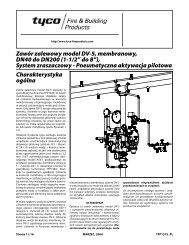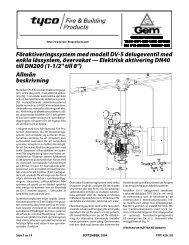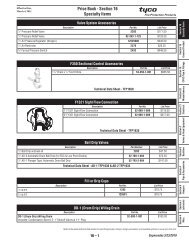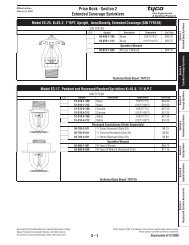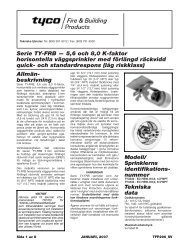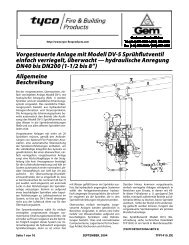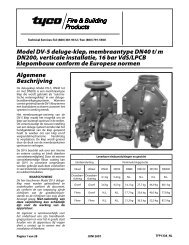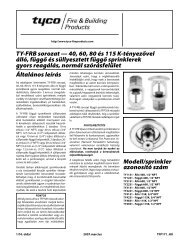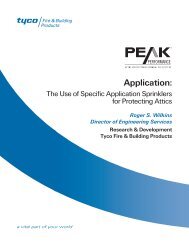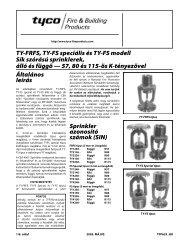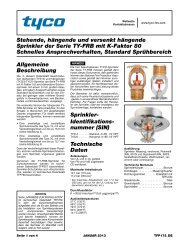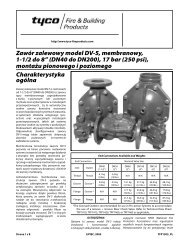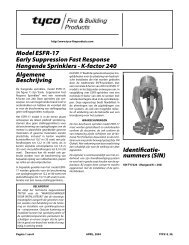Listings and Applications of Residential Sprinklers - Tyco Fire Products
Listings and Applications of Residential Sprinklers - Tyco Fire Products
Listings and Applications of Residential Sprinklers - Tyco Fire Products
You also want an ePaper? Increase the reach of your titles
YUMPU automatically turns print PDFs into web optimized ePapers that Google loves.
BACKGROUND / HISTORY<br />
RESIDENTIAL SPRINKLERS<br />
BACKGROUND<br />
Recent changes to the National <strong>Fire</strong> Protection Association (NFPA) St<strong>and</strong>ard 13D - Installation<br />
<strong>of</strong> Sprinkler Systems One <strong>and</strong> Two Family Dwellings <strong>and</strong> Manufactured Homes, St<strong>and</strong>ard 13R -<br />
Installation <strong>of</strong> Sprinkler Systems in <strong>Residential</strong> Occupancies up to <strong>and</strong> Including Four Stories in<br />
Height, <strong>and</strong> revisions to Underwriters Laboratory (UL) St<strong>and</strong>ard 1626 - St<strong>and</strong>ard for <strong>Residential</strong><br />
<strong>Sprinklers</strong> - have prompted the largest revision to residential sprinklers since the early 1980’s. Until<br />
these recent changes, manufacturers have held a wide variety <strong>of</strong> listings with applications <strong>of</strong><br />
residential sprinklers from sprinkler spacings <strong>of</strong> 12’ X 12’ to 20’ X 20’; <strong>and</strong> horizontal ceiling<br />
heights <strong>of</strong> 8 ft, to sloped ceilings with a pitch <strong>of</strong> 8/12 (rise over run) with unlimited ceiling<br />
heights. Additionally, discharge densities that had no specified minimums in the UL or NFPA<br />
st<strong>and</strong>ards resulted in <strong>Listings</strong> as low as .03-gpm/sq ft. This reduction is significant compared to the<br />
minimum density <strong>of</strong> .09-gpm/sq ft. density referenced in NFPA 13D in the 1980 to 1999 editions.<br />
In 2002, the UL Directory listed 110 Models <strong>of</strong> residential sprinklers with over 600 different<br />
applications. Both the NFPA 13D-2002 & NFPA 13R-2002 edition, with an effective date <strong>of</strong> August<br />
8, 2002 contain a new minimum discharge density <strong>of</strong> .05-gpm/sq ft for all residential sprinkler<br />
coverage areas. Although this is a reduction to the minimum densities specified by NFPA 13D <strong>and</strong><br />
NFPA 13R, it is an increase in flow rates from the special <strong>Listings</strong> manufacturers have obtained<br />
from UL over the past 20 years.<br />
HISTORY<br />
The first residential sprinkler Listing was granted to Grinnell’s Model F954 in 1981. The Listing<br />
was based on a maximum coverage area <strong>of</strong> 144 sq ft (12 ft x 12 ft maximum spacing). The<br />
minimum flow for the F954 was based on the NFPA 13D minimum <strong>of</strong> 18 gpm for a single<br />
sprinkler flow rate <strong>and</strong> 13 gpm for the multiple (two sprinklers) sprinkler flow rate. These<br />
minimum flow rates translate to equivalent .125-gpm/sq ft <strong>and</strong> .09gpm/sq ft densities. All<br />
residential sprinklers were required to meet these requirements unless they were Listed as<br />
equivalent. Beginning in the early 1980’s, Central Sprinkler utilized the Listing process to provide<br />
equivalent protection with lower flow rates combined with greater sprinkler spacing. Soon<br />
coverage areas up to 400 sq ft (20 ft x 20 ft) existed at densities as low as .03-gpm/sq ft. Extended<br />
coverage <strong>Listings</strong>, combined with lower flows, provided the industry with exactly what NFPA 13D<br />
was created for - a low cost life safety sprinkler system that allows the evacuation <strong>of</strong> occupants in<br />
the event <strong>of</strong> a fire in one <strong>and</strong> two family dwellings.<br />
[4]



